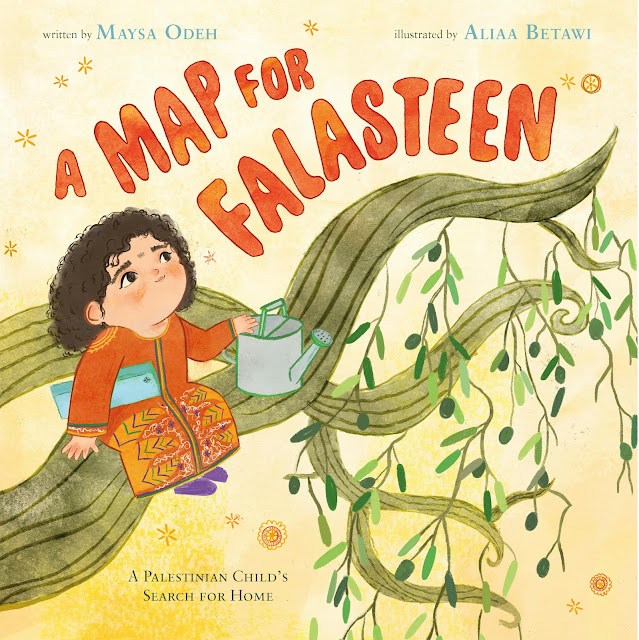Disclosure: I was sent copies of these books in exchange for an honest review. All opinions are my own.
What makes a place a home? What happens when you move? What about when your family left your home country before you were born? What if your home country is no longer on the map? Today I am sharing some picture books that help to answer some of these questions. One book is about moving and the other is about trying to find Palestine on a map and perhaps help the discussion that is needed with it. The first book is Home Is a Wish by Julia Kuo. It is recommended for ages 3 to 6.
From the Publisher:
A deeply moving, gorgeously illustrated picture book about leaving home and finding a new place to fit in, for anyone dealing with a move, to another town or to a new country.Sometimes we leave home in the mornings, in the evenings, or for much longer. But we always come back.
Home becomes a wish when we move, when the new place isn’t the same. Everything might be different: the sounds, the smell, the people, the weather.
But home isn’t just a place. We carry home in our hearts, and it can grow and change as we do in our lives. With time, new faces become friends, and what is different becomes familiar.
Home can be a wish that comes true.
Like Evelyn Del Rey Is Moving Away and The Day You Begin, this beautiful exploration of what it’s like to deal with a big change is personal, emotionally resonant, and relatable. With page after lovely page of captivating art, New York Times bestselling illustrator Julia Kuo has created a lasting story about how time, patience, and an open heart can help someone feel at home anywhere in the world.
From Me:
This book shares about how home is a place we leave and come back to but when we move, we do not usually return. It is hard to adjust to the new place. There may be new sights, smells and people. There could even be new rules. One often misses the old home but slowly the new place begins to feel like home as well.
A move can be very hard on a child. This book will hopefully help ease some of the difficulty. We have all been there. The new kid, new person or at a place that isn't home yet. We have to get used to the new places, new streets, new buildings, new directions, etc. For a child there is often a new school and new friends to make. I love how this book shares the difficulties of the move and transitioning to a new space from a child's point of view but also gives the message of that it will feel like home eventually as new habits are made. This book is perfect before a big move or just to talk about welcoming newcomers to a class or neighborhood.
Our next book shares the struggle of a young girl who is told to look for their homeland on a map, but hers isn't there. Her family is Palestinian. The book is A Map for Falasteen: A Palestinian Child's Search for Home by Maysa Odeh and illustrated by Aliaa Betawi. It is recommended for ages 4 to 8.
From the Publisher:
A Kirkus Best Book of 2024A Booklist Editors Choice 2024
A young Palestinian girl living in diaspora struggles to find her homeland on a map in this gentle and heartfelt picture book.
At school, Falasteen and her classmates are tasked with finding their families' home countries on a map, but no matter how hard she looks, Falasteen can't find Palestine.
Can a place exist if it's not on a map? Confused, Falasteen turns to her family for answers. Her grandfather, grandmother, and Mama encourage her to see their homeland from a different perspective, and each of their stories helps her understand her people's history and her own place in the world.
Filled with beautiful, inspiring illustrations and thoughtful back matter that outlines key terms and historical moments, this is a story of family, resilience and home always being where the heart is.
From Me:
The first few pages broke my heart. I cannot imagine a teacher telling the young girl that her homeland doesn't exist. I can only imagine how that made the girl feel. In the author's note, she shares that she always wondered why Palestine wasn't on the map if her family was from there. And I suppose the current news of the various demonstrations often at college campuses show how there are plenty of people who still feel like the teacher in this book. Even our President says the colleges are creating antiSemitic people and is threatening to take away funding. However, what about those of us who see both the Palestinians and Jews as people with rights. There is so much history in the land and so many groups of people who have claimed it over the millennia. It is hard to say whose land it truly is.
This book shares how to help young Palestinians deal with their homeland not being on the map. It gives words and ideas on how to answer the questions of why. It does not get into the politics of it although there is mention of soldiers arriving in the 1960s and the family fleeing. But the overall message of the book is that their homeland does still exist. Perhaps now with a different name, but the true homeland is in their hearts and their customs. It is a wonderful way of answering the questions and discussing with young children why Palestine is not labeled on the map. I can see this book read by Palestinian families but also read in classrooms when discussing family roots. It is important for all children to understand that their homeland is truly in the hearts of the people.









